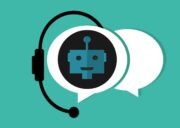
Digital virtual assistants have a wide range of applications that make them a great asset for business and leisure users. From powering smart technology to helping with workflow automation, they can be a great asset in our day-to-day lives at home and work.
Python is an incredibly versatile programming language and is a great option for building a digital virtual assistant. We will explore the benefits of using a digital virtual assistant and what makes Python the perfect tool to create one.
What Is a Digital Virtual Assistant?
A digital virtual assistant is a program that can complete tasks based on commands issued to it. They are somewhat akin to chatbots, although much more complex and able to handle much more complicated tasks. They do this by pulling information from multiple sources, which chatbots typically cannot.
The use of digital virtual assistants has increased rapidly in the last ten years, with many different assistants available on a wide range of hardware, from the Amazon Alexa Echo to Siri on the iPhone.
Many digital virtual assistants can also respond to voice commands. To do this, they need to be able to listen for and recognize commands, search databases, and other applications to find answers to queries, and finally relay the information back to the user or take the instructed action.
Using artificial intelligence (AI), they can recognize speech patterns in natural language, recognize faces, identify objects, and communicate with other software and applications to perform tasks. Many digital assistants learn over time from the inputs they receive, allowing them to grow ‘smarter’ the more they’re used.
Virtual assistants require access to large amounts of data to function. This data feeds the artificial intelligence platform, allowing it to perform its given tasks. Digital virtual assistants will also typically use machine learning, speech recognition, and natural language processing platforms to fulfill their duties.
What Can a Digital Virtual Assistant Do?
Digital virtual assistants can perform various tasks, and different types will have different capabilities depending on how they were programmed. They have applications across multiple industries, from healthcare to consumer electronics.
All digital virtual assistants work by pulling information from a variety of sources and most importantly, putting it into context. Here are a few tasks that digital virtual assistants perform:
- Add appointments to a calendar
- Place and answer telephone calls
- Compose and send SMS messages
- Provide updates on the weather
- Control smart home devices
- Give directions
- Play songs from a music streaming service
The most advanced digital virtual assistants feature natural language understanding (NLU) that enables them to understand complex verbal queries directed at them and respond with relevant answers. They can search databases, web pages, and other sources to answer these queries.
By using machine learning, digital virtual assistants can offer tailored responses to queries, considering the user’s past behavior. This could involve anything from offering them personalized product suggestions to making suggestions about what songs to listen to.
Digital virtual assistants also have applications in businesses, chiefly in a contact center environment. Here they can fulfill many tasks, from automatically transcribing telephone conversations with customers to directing calls to the most qualified agent to handle them using IVR software.
What Are the Advantages of Using a Digital Virtual Assistant?
In your day-to-day life, digital virtual assistants can help to eliminate time-consuming tasks by performing them for you.
If you’re out on a run and you receive a message from a colleague about a work meeting, your virtual assistant can read the message to you through your earphones. It can then create an appointment in your calendar for the meeting, and even set up an alert to remind you about it, all without having to stop and take your phone out of your armband.
In an omnichannel contact center environment, the advantages of using a digital virtual assistant become much more tangible and measurable, as they can improve your customer service and save your contact center teams time and money.
Along with using the best business phone systems from a RingCentral alternative, virtual assistants can improve the effectiveness of contact center agents with real-time transcription features. It enables agents and managers to look back over calls when they are finished and provides opportunities for coaching.
Features like live sentiment analysis can give managers an overview of how their agents are performing. Advanced natural language processing (NLP) features can analyze conversations for any negative sentiment from customers, alerting managers so they can provide advice to their agents if necessary.
Virtual assistants can be used to answer calls when no agents are available and in many instances, can solve queries without needing to involve an agent. It improves customer satisfaction by reducing the average handling time of incoming calls.
What Is Python?
Python is a programming language used to write programs for everything from data analysis to embedding white-label reports on your website. It is a general-purpose language, which means that it can be used in various programs and to solve many problems.
Here are just a few of the possible applications of Python:
- Data analysis
- Machine learning
- Web development
- Automation
- Software testing
Python is an incredibly popular programming language that has seen increased usage in recent years, overtaking Java as the most used programming language. This is mainly because of its versatility and how easy it is to use for both coders and non-coders alike.
What Are the Advantages of Using Python?
There are many reasons why Python has become the most widely used programming language and why it is great for building a digital virtual assistant.
Easy to Learn
Python has a simple, English-like syntax that mimics natural language, which makes it easy to read, understand, and write. It requires fewer lines of code to perform the same task than other programming languages like Java.
This is incredibly important as the way we work online changes. As practices such as cloud computing become more widely used, it’s crucial to rapidly adapt to the changing work environment to avoid being left behind by your competitors.
Support Libraries
Python has a wide array of libraries and modules that you can access. These are bundles of code developed by third-party users for various tasks. Whatever function you need to complete your task, chances are it has been developed and is ready and waiting for you to use.
Portable
Many programming languages require you to modify your code to run a program on different platforms. Python, however, does not. You only need to write the code once, and then it can be run virtually anywhere, as long as you haven’t included any system-dependent features.
This is especially helpful if you employ large numbers of employees that are working remotely and who may be using different devices and operating systems.
Versatile
Python is incredibly versatile. It performs many different tasks. This means you only need to master one programming language to automate all the tasks you want to, rather than learning specific languages for different tasks.
Free and Open Source
Because it’s an OSI-approved open-source license, Python is free to use and distribute. You can download the source code, modify it, and then distribute your version if you wish. This allows your organization to easily develop the programs you need without worrying about paying for expensive licenses.
Just be sure to implement robust internet security measures when downloading code from other sources, and try to avoid making common cloud security mistakes that can lead to problems with your network.
Active Community
Python is widely used, meaning there is a large and active community based around it. This means that if you run into issues when trying to use it, finding a solution is relatively easy because somebody else in the community will probably have had the same issue and can help you overcome it.
Just as high-paying affiliate programs can provide access to your product to a wider range of consumers, the Python community can provide access to a broader range of third-party source codes and channels of support.
Modules Needed to Build a Digital Virtual Assistant in Python
There are several modules that you’ll need to build a digital virtual assistant using Python, which will vary depending on what functions you need it to perform. Here are just a few examples of modules you may wish to use.
pyttsx3
This is a cross-platform text-to-speech library that can be used on any platform and while offline.
SpeechRecognition
This module allows for audio conversion into text so it can be processed.
webbrowser
This provides a high-level interface through which the assistant can search the web and display documents to users.
Wikipedia
Used to fetch information from Wikipedia pages, useful for answering general queries.
Use the Power of Python to Build Your Digital Virtual Assistant
Digital virtual assistants have various uses for everyday users and businesses. They can take the stress and hassle out of daily tasks at home and revolutionize a contact center environment, allowing your business to provide better customer service.
Python’s versatility and simplicity make it the perfect tool to build a digital virtual assistant with. Experienced coders and total novices alike can use its easy-to-understand language to quickly and easily get coding, saving time and stress.
If you’re considering building a digital virtual assistant, consider using Python. We’re sure you won’t regret it.




